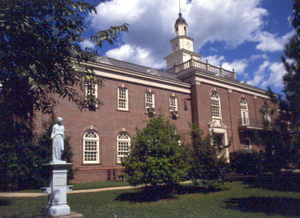
Lincoln County
Lincoln County is located in southern Middle Tennessee, with most of the county in the Central Basin and the remainder on the Highland Rim. The Elk River runs through the county from the northeast to the southwest, dividing the county into two nearly equal parts. The Cherokees and Chickasaws ceded the land that comprises Lincoln County in 1806. Settlers arrived almost immediately, although surveyors and prospective settlers came as early as 1784 to establish boundaries for Revolutionary War land warrants. Some of the first settlers included Drury Abbott; Ezekiel Norris; Joseph Alexander and Andrew Greer; William and Thomas Edmonson; Robert Farquharson; and James Bright. The county, which contains 520 square miles, was established by an act of the general assembly in 1809 and named for Revolutionary War hero General Benjamin Lincoln.
Commissioners John Whitaker Sr., Wright Williams, Eli Garrett, Littleton Duty, and Jesse Woodruff were appointed to purchase 100 acres near the center of the county to establish a county seat. Ezekiel Norris sold the land near the Elk River that became the town of Fayetteville, and the commissioners laid off town lots, which were sold in 1810. The first court was held in the home of Brice Garner, the first county clerk. In 1811 the first courthouse was constructed of logs. The present Colonial Revival-style courthouse was built in 1970 and is the fourth one in the county’s history.
The “Town Spring,” located on one of the lots, provided most of the town’s water until additional springs were discovered five miles south of Fayetteville at Rainy Falls. In 1899 the Fayetteville Gravity Flow Water System, completed at a cost of thirty-seven thousand dollars, brought fresh water to the town. This unique gravitational flow system excited the interest of engineers from as far away as New York and brought visitors to see the system in operation. Water flowed into a large reservoir located on a hill above Fayetteville at a rate of 225,000 gallons daily. The system provided water for families and mills until the 1920s when Fayetteville’s needs surpassed the capacity of the springs.
Lincoln County provided twenty-one companies of volunteers to the Confederate cause. Although no major battles were fought in Lincoln County, the area suffered severely from troop movements and the bands of armed men who raided, abused, robbed, and murdered defenseless people. Fortunately for the history of Lincoln County, the courthouse was not burned, and the county records were safely hidden by concerned citizens.
A number of small communities and villages dot the countryside. Most of the communities developed around local post offices, schools, churches, or stores. Today, the schools have been consolidated into the county system, the stores have closed, and the post office is in Fayetteville, but many communities still maintain their sense of pride and history. A few of the larger communities are Blanche, Taft, Coldwater, Dellrose, Elora, Flintville, Kelso, and Mulberry.
From 1875 to 1920 the Lincoln County economy depended on railroads. Petersburg, the county’s second largest town, was once a thriving railroad village. Located on the Marshall County line, Petersburg’s access to the Nashville, Chattanooga and St. Louis Railroad made it an important center for trade. It also was home to Morgan School, a well-respected prep school from the late nineteenth to mid-twentieth century.
During the twentieth century Lincoln County has supported a number of industries. Construction of the Elk Cotton Mills began in 1900, and the plant remained in operation until 1997. The Borden Milk Plant moved to Lincoln County in 1927 and is credited with the area’s economic survival during the Great Depression. The plant closed in 1962, and the National Register-listed facility now houses the Lincoln County Museum. Fayetteville had an electric system long before the Tennessee Valley Authority, and even some rural areas had electricity in the 1920s. Nevertheless, the arrival of TVA in 1935 brought enormous change to the lives of most Lincoln County residents. Textile mills once dominated the country’s industry, but of the four largest manufacturers (Amana, Frito-Lay, Lincoln County Manufacturing, and Copperweld Corporation) in the county in 2000, only Lincoln County Manufacturing, with 174 employees, produces textiles. Amana, a manufacturer of air conditioning and heating systems, is the largest employer, with 1,110 workers.
From its origins, agriculture has played a vital role in the county’s economy. Its rich and varied soils are suitable for a variety of crops, including corn, cotton, hay, tobacco, and Irish and sweet potatoes. In the 1930s and 1940s many local farmers entered the dairy business and supplied milk to Borden and Kraft Milk plants. Lincoln County now ranks among the top beef producers of the state.
Among Lincoln County’s most notable citizens is Retired Admiral Frank Kelso, who served as Commander and Chief of Naval Operations during the Persian Gulf War. He, along with less notable Lincoln Countians, including many descendants of early settlers, have made significant contributions to the state. According to the 2000 census, Fayetteville had 6,994 residents and Lincoln County had 31,340 residents.



